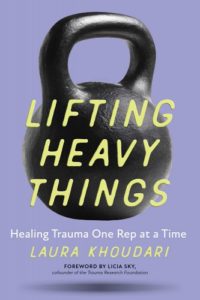have you ever seen someone using a kettlebell?
There are so many skills you can learn to do with a bell, but starting with the basics—deadlift, squat, carry, get up, and press—is key to creating good form and movement patterns. Once you’ve got your feet underneath you (literally and figuratively), you can learn the tougher stuff—like the clean, snatch, swing, and jerk—later on.
how do you decide what bell to pick up?
First—and most important—gender does not determine what you can and cannot lift or move. Can we repeat that for the people in the back? Gender does not determine what you can and cannot lift or move. Full stop.
What does matter is your experience with strength training and how comfortable you are with kettlebells. If you’ve used dumbbells and barbells before, you’ll be able to move kettlebells more easily than someone who has never picked up a weight before.
Use this chart to determine your starting bells:
| General Lifting Experience | Experience with Kettlebells | ||
| Just Starting Out | Some Experience | Seasoned Swinger | |
| I have not lifted any type of weight | 4kg – 10kg | 8kg – 16kg | 8kg – 20kg |
| I know my way around the gym | 8kg – 16kg | 8kg – 26kg | 12kg – 40kg |
Are you wondering how much a kilogram is in pounds?
One kilogram is equal to 2.2 pounds. So if you’re looking at a bell with a questioning eye, just do some quick math to switch it to pounds. But honestly, as soon as you get used to using bells, you’ll find yourself talking about all of the kgs you’re moving. (Let the others do the math to know what you’re talking about!)
what size of kettlebells are right for you?
Before you shop around for kettlebells, understand that you’ll need two different sizes, but three bells total:
- A pair of equally weighted bells that you can press overhead
- One heavier bell to use for different movements
These bells will take you a long way. Even if the bells are “too light” for you, there are many ways to make using them more challenging. When it comes to kettlebells, versatility equals accessibility.
RELATED: Book of the Month!
what kind of kettlebells should you get?
There are so many different types of bells available, it can be confusing to decide which ones to purchase. Here are a few “best bell” characteristics to look for when you’re shopping for your kettlebells.
Single-cast
A single-cast bell is from a single mold (as opposed to having the handle welded on as a second piece). No one wants a handle breaking during a swing. No one. Get yourself a single-case kettlebell.
Seamless and Burr-Free
Touch the handle (or read the reviews) to see if the handle feels smooth. You’ll need to transition the bell through your hands several times, so find one that doesn’t have any seams or burrs, which are imperfections in the metal.
Comfortable Handle Clearance
Make sure you have ample space between the bell and the handle. You want your hand to glide easily into the proper grip position so you can execute clean transitions within movements. Don’t buy fancy-shaped bells that look “cute” or “cool.”
Chip-Resistant
Many bells are painted different colors. Look for “chip-resistant” descriptions so you get a bell that feels good on your hands and doesn’t leave paint chips all over the floor.
need help finding the best bell?
I always recommend kettlebells from Kettlebell Kings. These are high-quality kettlebells and, as a bonus, they ship for free when you make a purchase of $150 or more.
join the FYS community!
Still haven’t signed up for FYS Community? Check it out on our programs page or sign up today!


